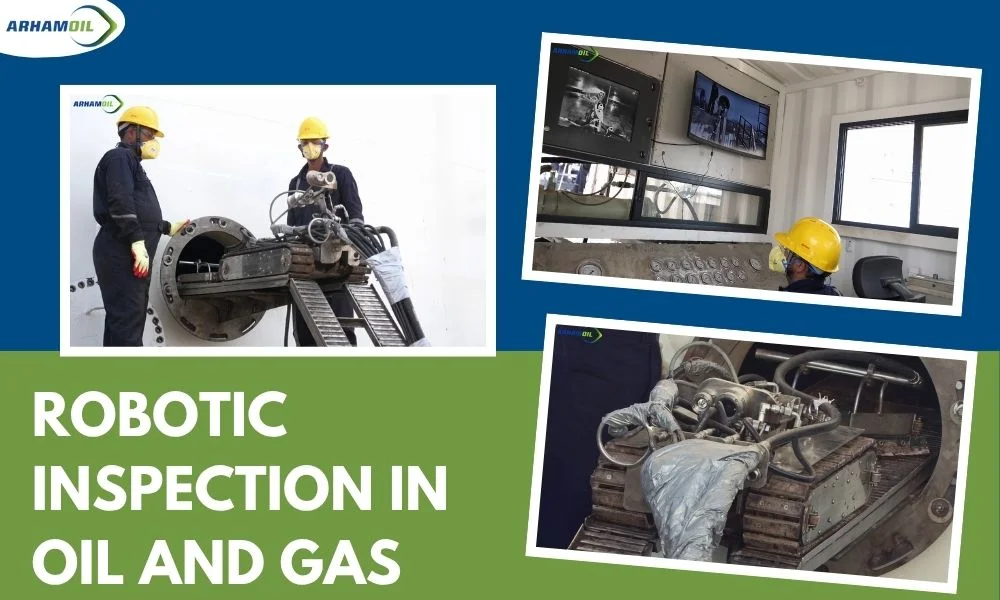Robots in the Oil Industry: Why Human Hands Are No Longer Needed in Hazardous Cleaning Jobs
May 28, 2025Robotic Hydroblasting in Oil and Gas
June 17, 2025In the complex and hazardous world of oil and gas, the ability to inspect pipelines, tanks, and infrastructure without interrupting operations is no longer a luxury—it’s a necessity. Robotic inspection is rapidly transforming how oil and gas companies maintain their assets, minimize risk, and stay compliant with industry regulations. At Arham Oil, we offer advanced robotic inspection solutions that provide unmatched safety, precision, and cost efficiency.
The Need for Robotic Inspection in the Oil & Gas Sector
Traditional inspection methods in oil and gas often involve confined space entry, shutdowns, scaffolding, and manual labor in high-risk environments. These outdated practices expose workers to harmful gases, explosive atmospheres, and structurally compromised components. They are also time-consuming and costly.
Robotic inspection eliminates many of these risks by utilizing remotely operated, highly intelligent robotic systems that can operate in hazardous, underwater, or explosive environments, while keeping humans safe and operations running smoothly.
What Is Robotic Inspection?
Robotic inspection refers to the use of remotely operated vehicles (ROVs), crawlers, drones, and autonomous systems equipped with sensors, cameras, and scanning tools to inspect infrastructure without human entry. These robotic systems are designed to navigate oil storage tanks, process vessels, pipelines, offshore platforms, and other hard-to-reach or hazardous environments.
They deliver real-time data on corrosion, cracks, weld integrity, sludge accumulation, wall thickness, and structural degradation—without the need for shutdowns or direct human involvement.
Applications of Robotic Inspection in Oil & Gas
1. Internal Tank Inspection
Tanks storing crude oil, chemicals, or wastewater require periodic inspection for corrosion, pitting, or sludge buildup. Our robotic crawlers and floating ROVs can enter tanks through manholes and carry out high-resolution 3D inspections without draining or degassing.
2. Pipeline Inspection
Pipelines carry hydrocarbons over long distances under extreme pressure and temperature. Internal robotic pigs or inline inspection tools (ILI) are used to detect metal loss, cracks, and geometric deformations. External crawlers equipped with ultrasonic or magnetic flux leakage sensors inspect buried or insulated pipelines from the outside.
3. Offshore Platform Monitoring
Offshore installations are constantly exposed to harsh weather, saltwater corrosion, and wave impact. Robotic drones and submersible ROVs inspect platform legs, risers, and underwater joints, enabling predictive maintenance and avoiding catastrophic failures.
4. Confined Space Inspection
Storage silos, separators, and reactors often have narrow entry points and limited ventilation. Our non-man-entry robotic tank cleaning with pan-tilt cameras and multi-sensor payloads allow remote visual inspection, gas monitoring, and thermal imaging without endangering personnel.
5. Flare Stack & Chimney Inspection
High vertical structures like flare stacks are difficult to access. We use aerial drones with HD and thermal cameras to detect cracks, corrosion, and heat anomalies at the top of flare stacks or chimneys—without scaffolding or shutdown.
Key Benefits of Robotic Inspection in Oil and Gas
- Enhanced Worker Safety
The most critical advantage of robotic inspection is safety. It eliminates the need for human entry into confined spaces, high-altitude structures, or explosive environments, significantly reducing exposure to life-threatening hazards. - Operational Continuity
Most robotic inspections can be performed while the equipment is online. There’s no need for draining tanks, isolating pipelines, or shutting down processes—saving millions in potential downtime costs. - Precision & Repeatability
Advanced sensors like laser scanners, ultrasonic probes, and thermal imagers allow robots to capture precise, repeatable measurements. This makes it easier to identify corrosion trends, predict failures, and take preventive action. - Comprehensive Data Capture
Our robotic systems collect high-definition images, videos, and 3D models. These are archived and used for compliance, auditing, or long-term asset integrity analysis, offering better insights than traditional methods. - Cost-Effective
Though the initial investment may seem higher, robotic inspection saves significantly on manpower, downtime, safety equipment, and post-inspection repair costs. It also helps prevent expensive unplanned shutdowns or accidents.
Why Choose Arham Oil for Robotic Inspection?
At Arham Oil, we combine our deep knowledge of oil and gas operations with cutting-edge robotic technology. Our team of petroleum engineers, robotic specialists, and NDT professionals ensures that every inspection is tailored to the specific needs of your facility.
We use state-of-the-art inspection robots that meet international safety and inspection standards. Whether it’s ultrasonic mapping of a storage tank, sonar scanning of sludge levels, or visual inspection of offshore structures, our robots can do it all, with zero man entry.
Real-Time Insights with Zero Disruption
Our robotic systems are designed to deliver real-time data to operators via secure control panels. Clients can watch the inspection as it happens, interact with the inspection team remotely, and receive instant reports and visuals. This transparency builds confidence and accelerates the decision-making process for maintenance and repairs.
Our Robotic Inspection Equipment
Here’s a snapshot of what we use for robotic inspections:
- Crawler Robots – For tank floors, vertical walls, and pipelines
- Aerial Drones – For flare stacks, roofs, and chimneys
- Underwater ROVs – For submerged pipelines and offshore platforms
- Sensor Payloads – Ultrasonic, visual, infrared, magnetic, laser, and gas detection
- Control Stations – Portable or mobile units for remote monitoring and recording
Ensuring Compliance and Integrity
We understand the compliance challenges oil and gas companies face under regulatory bodies like the DGMS, OISD, and API. Our robotic inspection reports are structured to meet these requirements. We provide:
- 3D visualizations
- Wall thickness maps
- Sludge accumulation profiles
- Crack or corrosion logs
- Thermal anomaly charts
These insights allow you to make informed decisions while staying fully compliant.
Final Thoughts: The Future Is Robotic
The oil and gas industry is evolving, and so should your inspection strategy. Robotic inspection isn’t just a trend; it’s the future of asset integrity management. At Arham Oil, we are committed to helping clients transition from risk-heavy, outdated methods to smarter, safer, and faster robotic inspections.
Let technology do the hard work while your team stays safe and your operations stay uninterrupted.


